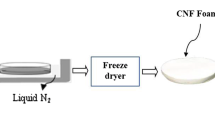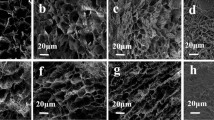Abstract
Cellulose-based aerogels have become a great potential for oil absorption applications due to their wide range of sources, low density, and good adsorption properties. However, many reported cellulose-based aerogels to have the drawbacks of low oil recovery rate and poor mechanical, which limit their application. In this study, high reusable and excellent mechanical properties silylated TEMPO-oxidized nanofibers/polyvinyl alcohol aerogels (STPA) were fabricated through a three-step process of aqueous silylation, bidirectional freezing, and freeze-drying. A bidirectional freezing technique was employed to obtain two unique structural aerogels by adjusting the methyltrimethoxysilane concentration. The STPA possessed many excellent physical properties, such as ultralight (9.79 mg/cm3), hydrophobicity (136°), and compressibility; as an adsorbent, STPA showed high adsorption capacity (51–111 g/g) for various types of organic solvents. Furthermore, the excellent compressibility enables STPA fast and highly efficient recovery of the absorbed oil by simple mechanical squeeze. It possesses an excellent oil recovery rate of 80% and maintains around 90% of its initial saturated absorption capacity after 50 cycles of absorption–squeezing. Therefore, the successful microstructure design of the biomass-aerogel through bidirectional freezing could provide new thoughts for the design of multifunctional oil absorbents and STPA with good mechanical properties and reusability showing promising prospects in the field of water treatment.
Graphical abstract









Similar content being viewed by others
References
Xiong J, Jiao C, Li C et al (2014) A versatile amphiprotic cotton fiber for the removal of dyes and metal ions. Cellulose 21:3073–3087. https://doi.org/10.1007/s10570-014-0318-z
Štefelová J, Slovák V, Siqueira G et al (2017) Drying and pyrolysis of cellulose nanofibers from wood, bacteria, and algae for char application in oil absorption and dye adsorption. ACS Sustain Chem Eng 5:2679–2692. https://doi.org/10.1021/acssuschemeng.6b03027
Ren R-P, Wang Z, Ren J, Lv Y-K (2019) Highly compressible polyimide/graphene aerogel for efficient oil/water separation. J Mater Sci 54:5918–5926. https://doi.org/10.1007/s10853-018-03238-1
Guo F, Jiang Y, Xu Z et al (2018) Highly stretchable carbon aerogels. Nat Commun 9:1–9. https://doi.org/10.1038/s41467-018-03268-y
Kabiri S, Tran DNH, Altalhi T, Losic D (2014) Outstanding adsorption performance of graphene–carbon nanotube aerogels for continuous oil removal. Carbon 80:523–533. https://doi.org/10.1016/j.carbon.2014.08.092
Li J, Li J, Meng H et al (2014) Ultra-light, compressible and fire-resistant graphene aerogel as a highly efficient and recyclable absorbent for organic liquids. J Mater Chem A 2:2934–2941. https://doi.org/10.1039/c3ta14725h
Liu J, Liu Y, Zhang H-B et al (2018) Superelastic and multifunctional graphene-based aerogels by interfacial reinforcement with graphitized carbon at high temperatures. Carbon 132:95–103. https://doi.org/10.1016/j.carbon.2018.02.026
Li J, Zhou L, Jiang X et al (2019) Directional preparation of superhydrophobic magnetic CNF/PVA/MWCNT carbon aerogel. IET Nanobiotechnol 13:565–570. https://doi.org/10.1049/iet-nbt.2018.5188
Yao X, Yu W, Xu X et al (2015) Amphiphilic, ultralight, and multifunctional graphene/nanofibrillated cellulose aerogel achieved by cation-induced gelation and chemical reduction. Nanoscale 7:3959–3964. https://doi.org/10.1039/C4NR07402E
Liu T, Huang M, Li X et al (2016) Highly compressible anisotropic graphene aerogels fabricated by directional freezing for efficient absorption of organic liquids. Carbon 100:456–464. https://doi.org/10.1016/j.carbon.2016.01.038
Xu Z, Zhou H, Jiang X et al (2017) Facile synthesis of reduced graphene oxide/trimethyl chlorosilane-coated cellulose nanofibres aerogel for oil absorption. IET Nanobiotechnol 11:929–934. https://doi.org/10.1049/iet-nbt.2017.0063
Mahadik SA, Mahadik DB, Kavale MS et al (2012) Thermally stable and transparent superhydrophobic sol–gel coatings by spray method. J Sol-Gel Sci Technol 63:580–586. https://doi.org/10.1007/s10971-012-2798-3
Yang S, Chen L, Mu L et al (2015) Low cost carbon fiber aerogel derived from bamboo for the adsorption of oils and organic solvents with excellent performances. RSC Adv 5:38470–38478. https://doi.org/10.1039/C5RA03701H
Hu H, Zhao Z, Gogotsi Y, Qiu J (2014) Compressible carbon nanotube-graphene hybrid aerogels with superhydrophobicity and superoleophilicity for oil sorption. Environ Sci Technol Lett 1:214–220. https://doi.org/10.1021/ez500021w
Sai H, Xing L, Xiang J et al (2014) Flexible aerogels with interpenetrating network structure of bacterial cellulose–silica composite from sodium silicate precursor via freeze drying process. RSC Adv 4:30453–30461. https://doi.org/10.1039/C4RA02752C
Zhang Z, Tingaut P, Rentsch D et al (2015) Controlled Silylation of nanofibrillated cellulose in water: reinforcement of a model polydimethylsiloxane network. Chemsuschem 8:2681–2690. https://doi.org/10.1002/cssc.201500525
Zhang Z, Sèbe G, Rentsch D et al (2014) Ultralightweight and flexible silylated nanocellulose sponges for the selective removal of oil from water. Chem Mater 26:2659–2668. https://doi.org/10.1021/cm5004164
Wu Y, Yi N, Huang L et al (2015) Three-dimensionally bonded spongy graphene material with super compressive elasticity and near-zero Poisson’s ratio. Nat Commun 6:1–9. https://doi.org/10.1038/ncomms7141
Zhang X, Wang H, Cai Z et al (2019) Highly compressible and hydrophobic anisotropic aerogels for selective oil/organic solvent absorption. ACS Sustain Chem Eng 7:332–340. https://doi.org/10.1021/acssuschemeng.8b03554
Yang M, Zhao N, Cui Y et al (2017) Biomimetic architectured graphene aerogel with exceptional strength and resilience. ACS Nano 11:6817–6824. https://doi.org/10.1021/acsnano.7b01815
Si Y, Wang X, Yan C et al (2016) Ultralight biomass-derived carbonaceous nanofibrous aerogels with superelasticity and high pressure-sensitivity. Adv Mater 28:9512–9518. https://doi.org/10.1002/adma.201603143
Mi H-Y, Jing X, Politowicz AL et al (2018) Highly compressible ultra-light anisotropic cellulose/graphene aerogel fabricated by bidirectional freeze drying for selective oil absorption. Carbon 132:199–209. https://doi.org/10.1016/j.carbon.2018.02.033
Zhang H, Cooper AI (2007) Aligned porous structures by directional freezing. Adv Mater 19:1529–1533. https://doi.org/10.1002/adma.200700154
Saito T, Isogai A (2004) TEMPO-mediated oxidation of native cellulose. The effect of oxidation conditions on chemical and crystal structures of the water-insoluble fractions. Biomacromol 5:1983–1989. https://doi.org/10.1021/bm0497769
Wang C, Ma R, Huang Z et al (2021) Preparation and characterization of carboxymethylcellulose based citric acid cross-linked magnetic aerogel as an efficient dye adsorbent. Int J Biol Macromol 181:1030–1038. https://doi.org/10.1016/j.ijbiomac.2021.04.078
Liao Q, Su X, Zhu W et al (2016) Flexible and durable cellulose aerogels for highly effective oil/water separation. RSC Adv 6:63773–63781. https://doi.org/10.1039/C6RA12356B
Zhao S, Zhang Z, Sèbe G et al (2015) Multiscale assembly of superinsulating silica aerogels within silylated nanocellulosic scaffolds: improved mechanical properties promoted by nanoscale chemical compatibilization. Adv Funct Mater 25:2326–2334. https://doi.org/10.1002/adfm.201404368
Deville S (2008) Freeze-casting of porous ceramics: a review of current achievements and issues. Adv Eng Mater 10:155–169. https://doi.org/10.1002/adem.200700270
Wicklein B, Kocjan A, Salazar-Alvarez G et al (2015) Thermally insulating and fire-retardant lightweight anisotropic foams based on nanocellulose and graphene oxide. Nat Nanotechnol 10:277–283. https://doi.org/10.1038/nnano.2014.248
Chen T, Zhang J, Shi P et al (2018) Thalia dealbata Inspired Anisotropic Cellular Biomass Derived Carbonaceous Aerogel. ACS Sustain Chem Eng 6:17152–17159. https://doi.org/10.1021/acssuschemeng.8b04528
Author information
Authors and Affiliations
Corresponding authors
Ethics declarations
Conflict of interest
The authors declare no conflict of interest.
Additional information
Handling Editor: Stephen Eichhorn.
Publisher's Note
Springer Nature remains neutral with regard to jurisdictional claims in published maps and institutional affiliations.
Supplementary Information
Below is the link to the electronic supplementary material.
Supplementary file2 (MP4 120470 KB)
Rights and permissions
About this article
Cite this article
Feng, P., Wang, X. & Yang, J. Highly compressible and hydrophobic anisotropic cellulose-based aerogel fabricated by bidirectional freeze-drying for selective oil absorption. J Mater Sci 57, 13097–13108 (2022). https://doi.org/10.1007/s10853-022-07418-y
Received:
Accepted:
Published:
Issue Date:
DOI: https://doi.org/10.1007/s10853-022-07418-y




